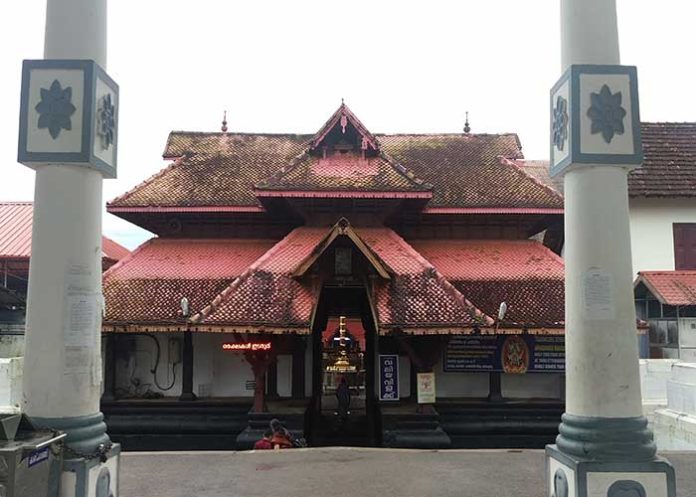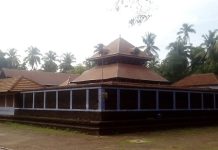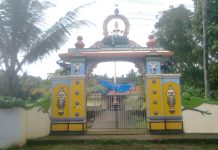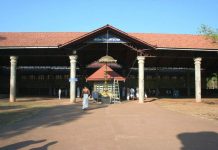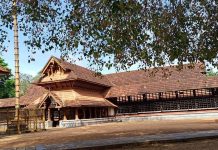The asura, Khara, after arduous prayers, got three Shivalingams from Lord Shiva. He brought them down to Kerala, holding one each in left and right hand and one by his teeth. The Lingam held by his teeth was consecrated in Kaduthuruthi (held by the mouth and put), the one held in his right hand was consecrated in Vaikom and the one in the left hand at Ettumanoor.
Just 10 km from Kottayam, towards Ernakulam, lies the temple town of Ettumanoor. This is the abode of the fierce form of the Lord, the Aghora Moorthy. There is a large compound separating the actual temple from the Main road, providing parking spaces. Then you descend some steps and enter this famous temple. Right in front, inside the temple is the golden flag staff, topped with an idol of a bull surrounded by small bells and metal banyan tree leaves.
On your left is a makeshift counter selling puja material including oil. A big “Kedavilakku” (the lamp-lit without break) in front of the temple is noteworthy. The devotees offer oil to this lamp which is regarded as the representation of Lord Shiva.
There is a story behind this lamp. One day a devotee brought this lamp to temple and requested the temple authorities to use it. But the authorities rejected his offering and laughed at him. The devotee was deeply hurt; he prayed to Lord Shiva. A violent thunder storm erupted suddenly. The authorities sensed the displeasure of the Lord over their behaviour. So, they accepted the lamp and placed it just in front of the temple.
The black oily soot obtained as a result of the burning of the wick in this lamp, which accumulates on a circular plate above the lamp, is considered very good for the eyes. Also, when children have bad dreams in sleep, application of this ‘Mashi’ calms them down and thwarts such bad dreams. I try and keep some of this mashi in powder form at my home always.
The temple is very artistically constructed and has a copper roof. Several wooden sculptures can be found around the temple. There are also statues of two bulls in this temple. There are also temples for Dakshinamurthy (very rare in Kerala), Ganapathi and Sastha in this temple. The idol of Dakshinamurthy, also of Shiva, is considered as a more benign image.
The image of the Lord, facing West, is a two feet high Lingam installed on high pedestal. To enable devotees to meditate, a beautiful vigraha is placed in front of the Lingam after the morning abhisheka. On the East side, Goddess Parvathy is imagined and prayed to. One can only see a closed door there.
Ettumanoor Mahadeva Temple is famous for its unique festival of Ezhara Ponnana. Celebrated in the Malayalam month of Kumbham (February – March), one of the elegant sights associated with this temple festival is the ‘Ezhara Ponnana’ procession (carrying golden elephant statues). ‘Ezhara’ means seven-and-half and ‘Ponnana’ means golden elephant. Each of the seven elephants is two feet high and the eighth one is of one foot only. Hence, they are together called seven-and-half elephants. It is on the night of the eighth-day of the festival that the devotees can witness the procession of these golden elephants.
According to popular belief, the Vaikom and Ettumanoor deities are not on good terms with each other, though both shrines are dedicated to Lord Shiva. Back in 1798, Maharaja of Travancore, had a dream that the Vaikom deity- Lord Mahadeva had asked for an offering of eight elephants. The Maharaja immediately ordered for eight wooden elephants plated in gold to be made and sent these with his trusted men to the Vaikom temple. As the entourage carrying the elephants reached Ettumanoor temple, the hungry and tired men handed over the elephants to temple guards for the safekeeping and went to bathe and eat. When they returned, they were taken aback to find that every single elephant had a serpent coiled on it with its hood spread in an attacking posture. The Maharaja’s men tried every trick in the book, but the snakes wouldn’t budge. Helpless and crestfallen as they could not reclaim the elephants the men went back to the king and reported the strange incident. The Maharaja immediately consulted his astrologers and found out that the Ettumanoor deity was unwilling to let go off the elephants and was staking claim on the gift meant for the Vaikom deity.
As there was no other way out, the Maharaja decided to get another set of eight elephants made and sent to Vaikom Deity. That night the Vaikom Deity approached the Maharaja in his dream saying he is no longer interested in the offering of elephants and instead a special ritual should be conducted for him using the same expense. This was done immediately. However, this did not bring peace between two deities. It is believed that the two deities are still not on ‘talking terms’ with each other. This is confirmed by the practice of Ettumanoor residents boycotting the Vaikom celebrations on Ashtami every year.
For many years I have visited this temple regularly, at least twice a year. There is a practice of symbolic giving-up-of-your-child to the deity here. The infant is left in front of the main temple and parents appear to walk away. The priest then claps his hands and calls them back. Then the parents pay some money and take the child. The meaning being, that, from then on, the child belongs to the Lord and you are only a caretaker. Custom is that if a girl undergoes this custom, then her offsprings will also need to go through it. It is called ‘Adima Kadathal’ in Malayalam. Whilst this is practised in many temples, the peculiarity here is that a child who undergoes this ceremony here, cannot go and pray at the Shiva Temple at Vaikom. Consequently, I have never visited the Vaikom temple.
Whilst, the Lord here is quick to get offended and angry, and demands total loyalty, He is protective to His devotees and guards them from all evil.
When you get a chance, do visit this temple and pay homage to the mighty Lord.


























